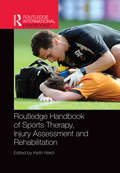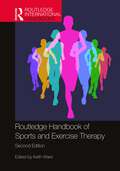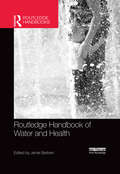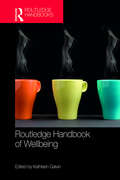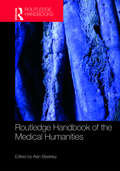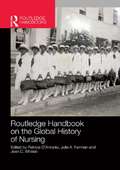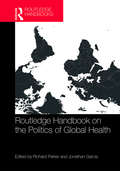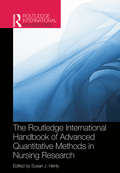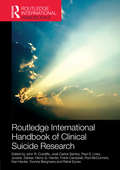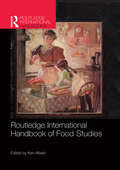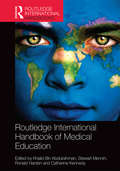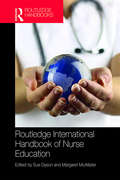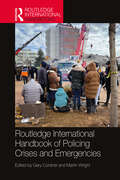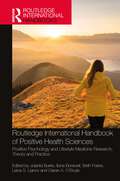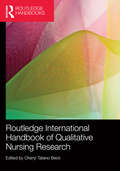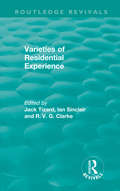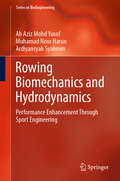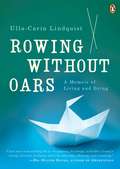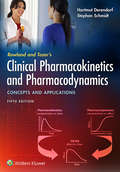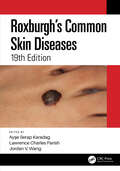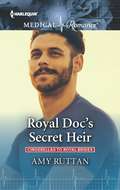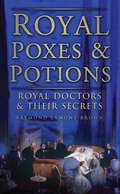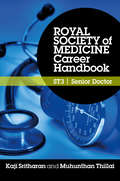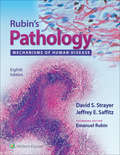- Table View
- List View
Routledge Handbook of Sports Therapy, Injury Assessment and Rehabilitation (Routledge International Handbooks)
by Keith WardThe work of a sports therapist is highly technical and requires a confident, responsible and professional approach. The Routledge Handbook of Sports Therapy, Injury Assessment and Rehabilitation is a comprehensive and authoritative reference for those studying or working in this field and is the first book to comprehensively cover all of the following areas: Sports Injury Aetiology Soft Tissue Injury Healing Clinical Assessment in Sports Therapy Clinical Interventions in Sports Therapy Spinal and Peripheral Anatomy, Injury Assessment and Management Pitch-side Trauma Care Professionalism and Ethics in Sports Therapy The Handbook presents principles which form the foundation of the profession and incorporates a set of spinal and peripheral regional chapters which detail functional anatomy, the injuries common to those regions, and evidence-based assessment and management approaches. Its design incorporates numerous photographs, figures, tables, practitioner tips and detailed sample Patient Record Forms. This book is comprehensively referenced and multi-authored, and is essential to anyone involved in sports therapy, from their first year as an undergraduate, to those currently in professional practice.
Routledge Handbook of Sports and Exercise Therapy (Routledge International Handbooks)
by Keith WardThe Routledge Handbook of Sports and Exercise Therapy is a methodically detailed, authoritative, contemporaneous and practical reference source for all those involved in sports and exercise therapy, whether students, established practitioners, educators or researchers. This comprehensive handbook cohesively presents foundational subjects and introduces principles and applications to support the development and practice of sports and exercise therapists.These are presented alongside new essential and evolving topic areas. Such a blend of fundamental underpinning and applied and experiential practical guidance gives this handbook a real sense of relevancy, and a contribution which can help to consolidate the positioning of sports and exercise therapists as key practitioners in an advancing landscape of health, exercise, sport, research and education. The handbook has been produced to create a seamless reference source for readers, but each of its chapters are also designed to be stand-alone presentations in their own right. The following areas are covered: Learning and teaching Evidence-based practice Anatomy and physiology Pathology of injuries Health and safety Clinical assessment Therapeutic modalities Injury rehabilitation Sports and exercise as medicine Sports and exercise nutrition Sports and exercise psychology Professionalism and ethics Structural and cultural competency Sideline sports injury management Management of regional injury conditions Case studies in sports and exercise therapy Employability and career development The handbook is comprehensively referenced and multi-authored. Its design incorporates numerous photographs, figures, tables and detailed sample document templates. It can be considered as an essential and topical resource for anyone involved in sports and exercise therapy, whether in their first year as an undergraduate or already working in professional practice.
Routledge Handbook of Water and Health (Routledge Environment and Sustainability Handbooks)
by Jamie BartramThis comprehensive handbook provides an authoritative source of information on global water and health, suitable for interdisciplinary teaching for advanced undergraduate and postgraduate students. It covers both developing and developed country concerns. It is organized into sections covering: hazards (including disease, chemicals and other contaminants); exposure; interventions; intervention implementation; distal influences; policies and their implementation; investigative tools; and historic cases. It offers 71 analytical and engaging chapters, each representing a session of teaching or graduate seminar. Written by a team of expert authors from around the world, many of whom are actively teaching the subject, the book provides a thorough and balanced overview of current knowledge, issues and relevant debates, integrating information from the environmental, health and social sciences.
Routledge Handbook of Well-Being
by Kathleen T. GalvinThe Routledge Handbook of Well-Being explores diverse conceptualisations of well-being, providing an overview of key issues and drawing attention to current debates and critiques. Taken as a whole, this important work offers new clarification of the widely used notion of well-being, focusing particularly on experiential perspectives. Bringing together leading authors from around the world, Routledge Handbook of Well-Being reflects on: What it is that is experienced by humans that can be called well-being. What we know about how to understand it. How well-being is manifested in human endeavours through a wide range of disciplines, including the arts. This comprehensive reference work will provide an authoritative overview for students, practitioners, researchers and policy makers working in or concerned with well-being, health, illness and the relation between all three across a range of disciplines, from sociology, healthcare and economics to philosophy and the creative arts.
Routledge Handbook of the Medical Humanities
by Bleakley AlanThis authoritative new handbook offers a comprehensive and cutting-edge overview of the state of the medical humanities globally, showing how clinically oriented medical humanities, the critical study of medicine as a global historical and cultural phenomenon, and medicine as a force for cultural change can inform each other. Composed of eight parts, the Routledge Handbook of the Medical Humanities looks at the medical humanities as: a network and system therapeutic provocation forms of resistance a way of reconceptualising the medical curriculum concerned with performance and narrative mediated by artists as diagnosticians of culture through public engagement. This book describes how the medical humanities can be used in and out of clinical settings, acting as a point of resistance, redistributing medicine’s capital amongst its stakeholders, embracing the complexity of medical instances, shaping medical education, promoting interdisciplinary understandings and recognising an identity for the medical humanities as a network effect. This book is an essential read for all students, scholars and practitioners with an interest in the medical humanities.
Routledge Handbook on the Global History of Nursing NIP
by Patricia D'Antonio Julie A. Fairman Jean C. WhelanA CHOICE Outstanding Academic Title 2014! 2014 winner of the American Association for the History of Nursing’s Mary M. Roberts Award for Exemplary Historical Research and Writing! The Routledge Handbook on the Global History of Nursing brings together leading scholars and scholarship to capture the state of the art and science of nursing history, as a generation of researchers turn to the history of nursing with new paradigms and methodological tools. Inviting readers to consider new understandings of the historical work and worth of nursing in a larger global context, this ground-breaking volume illuminates how research into the history of nursing moves us away from a reductionist focus on diseases and treatments and towards more inclusive ideas about the experiences of illnesses on individuals, families, communities, voluntary organizations, and states at the bedside and across the globe. An extended introduction by the editors provides an overview and analyzes the key themes involved in the transmission of ideas about the care of the sick. Organized into four parts, and addressing nursing around the globe, it covers: New directions in the history of nursing; New methodological approaches; The politics of nursing knowledge; Nursing and its relationship to social practice. Exploring themes of people, practice, politics and places, this cutting edge volume brings together the best of nursing history scholarship, and is a vital reference for all researchers in the field, and is also relevant to those studying on nursing history and health policy courses.
Routledge Handbook on the Politics of Global Health
by Richard Parker Jonathan GarcíaIn the early twenty-first century, key public health issues and challenges have taken centre stage on the global scene, and health has been placed at the heart of our collective aspirations for human development and well-being. But significant debate exists not only about the causes, but also about the possible solutions for nearly all of the most important global health challenges. Competing visions of the values and perspectives that should underlie global health policies have emerged, ranging from an emphasis on cost eff ectiveness and resource constraints on one extreme, to new calls for health and human rights, and renewed calls for health and social justice on the other. The role of different intergovernmental agencies, bilateral or unilateral donors, public or private institutions and initiatives, has increasingly been called into question, whilst the spread of neoliberal policies and programmes, and existing international trade regimes and intellectual property rights, are deeply implicated in relation to global health responses. This volume critically evaluates how the global health industry has evolved and how the interests of diverse political and economic stakeholders are shaping the context of a rapidly changing institutional landscape. Bringing together leading authors from across the world, the Handbook’s eight sections explore: • Critical perspectives on global health • Globalisation, neoliberalism, and health systems • The changing shape of global health governance • Development assistance and the politics of global health • Scale-up, scale-down, and the sustainability of global health programmes • Intellectual property rights, trade relations, and global health • Humanitarian emergencies and global health politics • Human rights, social justice, and global health The Routledge Handbook on the Politics of Global Health addresses both the emerging issues and conceptualisations of the political strategies, policy-making processes, and global governance of global health, along with expanding upon and highlighting the critical priorities in this rapidly evolving field. It provides an authoritative overview for students, practitioners, researchers, and policymakers working in or concerned with the politics of public health around the globe.
Routledge International Handbook of Advanced Quantitative Methods in Nursing Research
by Susan J. HenlyDesigned to support global development of nursing science, the Routledge International Handbook of Advanced Quantitative Methods in Nursing Research provides a new, comprehensive, and authoritative treatment of advanced quantitative methods for nursing research. Incorporating past approaches that have served as the foundation for the science, this cutting edge book also explores emerging approaches that will shape its future. Divided into six parts, it covers: -the domain of nursing science - measurement—classical test theory, IRT, clinimetrics, behavioral observation, biophysical measurement -models for prediction and explanation—SEM, general growth mixture models, hierarchical models, analysis of dynamic systems -intervention research—theory-based interventions, causality, third variables, pilot studies, quasi-experimental design, joint models for longitudinal data and time to event -e-science—DIKW paradigm, big data, data mining, omics, FMRI -special topics—comparative effectiveness and meta-analysis, patient safety, economics research in nursing, mixed methods, global research dissemination Written by a distinguished group of international nursing scientists, scientists from related fields, and methodologists, the Handbook is the ideal reference for everyone involved in nursing science, whether they are graduate students, academics, editors and reviewers, or clinical investigators.
Routledge International Handbook of Clinical Suicide Research
by Paul S. Links Henry G. Harder José Carlos Santos John R. Cutcliffe Juveria Zaheer Frank Campbell Rod McCormick Kari Harder Yvonne Bergmans Rahel EynanSuicide remains one of the most pressing public health concerns across the world. Expensive in terms of the human cost and associated suffering, the economic costs, the social costs and the spiritual costs, it affects millions of people every year. This important reference work collects together a wide range of research around suicide and suicide prevention, in order to guide future research and provide guidance for professionals about the best way to respond meaningfully to suicidal patients. Responding to the need for multi-disciplinary and international research to deepen our understanding of suicide, it demonstrates where our knowledge is firmly evidence-based and where new areas for research are emerging, as well as highlighting where we know little. Divided into six parts, each with its own editorial introduction and commentary, it explores research with and about survivors of suicide and indigenous populations. The remaining sections look at suicide-focused research in psychiatric nursing, psychiatry, psychology, and social work and allied health. It is of interest to all advanced students, practitioners and scholars interested in suicide and its impact and prevention.
Routledge International Handbook of Food Studies (Routledge International Handbooks)
by Ken AlbalaOver the past decade there has been a remarkable flowering of interest in food and nutrition, both within the popular media and in academia. Scholars are increasingly using foodways, food systems and eating habits as a new unit of analysis within their own disciplines, and students are rushing into classes and formal degree programs focused on food. Introduced by the editor and including original articles by over thirty leading food scholars from around the world, the Routledge International Handbook of Food Studies offers students, scholars and all those interested in food-related research a one-stop, easy-to-use reference guide. Each article includes a brief history of food research within a discipline or on a particular topic, a discussion of research methodologies and ideological or theoretical positions, resources for research, including archives, grants and fellowship opportunities, as well as suggestions for further study. Each entry also explains the logistics of succeeding as a student and professional in food studies. This clear, direct Handbook will appeal to those hoping to start a career in academic food studies as well as those hoping to shift their research to a food-related project. Strongly interdisciplinary, this work will be of interest to students and scholars throughout the social sciences and humanities.
Routledge International Handbook of Medical Education (Routledge International Handbooks)
by Khalid A. Abdulrahman Stewart Mennin Ronald Harden Catherine KennedyTwenty-first century medical schools, postgraduate bodies and other medical education organisations are responding to rapid advances in medicine, healthcare delivery, educational approaches and technology, and globalisation. Differences in geography, culture, history and resources demand diversity amongst educational systems. This important volume is designed to help medical educators working in today’s challenging circumstances by providing an overview of best practices and research in medical education. Routledge International Handbook of Medical Education provides a practical guide to and theoretical support for the major education challenges facing teachers, managers and policy makers around the world. Highlighting how resources can be used to provide effective and sustainable responses to the key issues facing medical educators, the handbook offers a truly international perspective of best practices with contributing editors and authors from around the globe. Routledge International Handbook of Medical Education recognises the need to maintain established best practices when appropriate and to respond adaptively to cultural differences and local conditions facing medical education. This topical book deals with the key challenges facing medical education by the different stakeholders including: - selection and admission of students to study medicine; - competences necessary for graduates to enable them to recognize and address emerging health issues and policies; - teaching and learning processes that are necessary to meet tomorrow's challenges; - approaches to assessment, including the integration of assessment and learning; - design and management of complex curricula that provide educational strategies to meet regional and global problems. A unique, diverse and illustrative resource of best practices in medical education, the handbook is stimulating reading for all educators of present and future health care professionals.
Routledge International Handbook of Nurse Education
by Sue Dyson Margaret McAllisterWhile vast numbers of nurses across the globe contribute in all areas of healthcare delivery from primary care to acute and long-term care in community settings, there are significant differences in how they are educated, as well as the precise nature of their practice. This comprehensive handbook provides a research-informed and international perspective on the critical issues in contemporary nurse education. As an applied discipline, nursing is implemented differently depending on the social, political and cultural climate in any given context. These factors impact on education, as much as on practice, and are reflected in debates around the value of accredited programmes, and on-the-job training, apprenticeship, undergraduate and postgraduate pathways into nursing. Engaging with these debates amongst others, the authors collected here discuss how, through careful design and delivery of nursing curricula, nurses can be prepared to understand complex care processes, complex healthcare technologies, complex patient needs and responses to therapeutic interventions, and complex organizations. The book discusses historical perspectives on how nurses should be educated; contemporary issues facing educators; teaching and learning strategies; the politics of nurse education; education for advanced nursing practice; global approaches; and educating for the future. Bringing together leading authorities from across the world to reflect on past, present and future approaches to nurse education and nursing pedagogy, this handbook provides a cutting-edge overview for all educators, researchers and policy-makers concerned with nurse education.
Routledge International Handbook of Policing Crises and Emergencies (Routledge International Handbooks)
by Gary Cordner Martin WrightThis handbook explores those occasions when the police are faced with a public, national, or international crisis and are expected to continue to serve. It provides a unique, scholarly, and international overview on policing crises and emergencies, addressing the different contexts and challenges of working in extraordinary circumstances, dealing with unfamiliarity, and working with and alongside other agencies, as well as the significant political and public requirement to return as quickly as possible to normality. Sections include coverage of:• Policing disasters• Policing public health emergencies• Policing political protest• Policing terror and conflict• Policing mass violence• Policing extreme crises and emergenciesEach section is filled with a variety of international case studies examining best practice in the policing context, together with a scene-setting chapter tying together key theoretical and conceptual concepts. It is essential reading for all engaged with professional policing, law enforcement, and public order.
Routledge International Handbook of Positive Health Sciences: Positive Psychology and Lifestyle Medicine Research, Theory and Practice (Routledge International Handbooks)
by Ilona Boniwell Jolanta Burke Beth Frates Ciaran A. O’Boyle Liana S. LianovThis ground-breaking book combines research and practice in the rapidly growing field of Positive Psychology with the fastest-growing medical speciality of Lifestyle Medicine. Section 1 maps out the new field of positive health by exploring the scope, content and architecture of this rapidly emerging area of research. It explores research findings and applications derived from Lifestyle Medicine and Positive Psychology that are critical for positive health. Section 2 delves into positive health research, covering topics such as using character strengths to improve health, maximising psychological wellbeing from head to toe, optimising gut health and understanding the relationships between mind and body. Section 3 offers guidance on applying the principles of positive health by describing new Positive Health Interventions (PHIs), introducing innovative positive health coaching models and exploring the contribution of positive psychology to health equity. The book is ideal for medical doctors, nurses and health professionals interested in helping their patients flourish psychologically and physically. It is an invaluable guide for social workers, positive psychologists, coaches and mental health professionals who want to explore the physiological dimensions of wellbeing.
Routledge International Handbook of Qualitative Nursing Research
by Cheryl Tatano BeckQualitative research, once on the fringes, now plays a central part in advancing nursing and midwifery knowledge, contributing to the development of the evidence base for healthcare practice. Divided into four parts, this authoritative handbook contains over forty chapters on the state of the art and science of qualitative research in nursing. The first part begins by addressing the significance of qualitative inquiry to the development of nursing knowledge, and then goes on to explore in depth programs of qualitative nursing research. The second section focuses on a wide range of core qualitative methods, from descriptive phenomenology, through to formal grounded theory and to ethnography, and narrative research. The third section highlights key issues and controversies in contemporary qualitative nursing research, including discussion of ethical and political issues, evidence-based practice and Internet research. The final section takes a unique look at qualitative nursing research as it is practiced throughout the world with chapters on countries and regions from the UK and Europe, North America, Australasia, Latin America, to Japan, China, and Korea. With an international selection of established scholars contributing, this is an essential overview and will help to propel qualitative research in nursing well into the twenty-first century. It is an invaluable reference for all nursing researchers.
Routledge Revivals: Varieties Of Residential Experience (1975) (Routledge Revivals)
by Ian Sinclair Jack Tizard R.V.G. ClarkeFirst published in 1975, this book compiles a number of studies concerning institutional care and children, which address the question of why institutions that serve apparently similar functions differ so much. The book uses comparative methods such as measurement of different ‘dimensions’ of institutional care and analysis of interrelationships among specific structural and functional features which characterise particular institutions. As a result, the book draws broad conclusions about the importance of factors that have dynamic influence on the manner in which institutions function and the reasons why they differ. The editors reject the ‘steampress’ model which postulates that institutions are more or less alike. They discuss ideological and organisational variation, differences in staffing and the manner in which children respond to them, and consider these issues as factors that influence the way in which an institution functions ‘as a whole’. Subsequent chapters describe comparative studies carried out in institutions for the mentally handicapped, approved schools, residential nurseries, probation hostels, other ‘correctional’ institutions and units for autistic children. The book enables the reader to appreciate achievements and shortcomings of contemporary research and thinking in this field.
Rowing Biomechanics and Hydrodynamics: Performance Enhancement Through Sport Engineering (Series in BioEngineering)
by Muhamad Noor Harun Ardiyansyah Syahrom Ab Aziz Mohd YusofThis book introduces engineering principles into the sport of rowing by the integration of rower biomechanics, stroke style, and blade hydrodynamics to improve the rowing performance in the sport. The book starts with an essential overview of rowing, covering its history, governing organizations, and the stroke phases. It looks into the biomechanical and hydrodynamic aspects, emphasizing different body segments and stroke styles contributing to rower performance. Key performance parameters are discussed, such as peak force, stroke rate, and hydrodynamic force. It also highlights the utilization of dynamic rowing simulators and specialized sensors to collect crucial performance assessment and improvement data. By addressing the engineering aspects of the sport, the book offers the potential for performance enhancement, ultimately benefiting the rowing community and advancing sports science.
Rowing Without Oars: A Memoir of Living and Dying
by Ulla-Carin Lindquist Margaret MyersIn the tradition of The Diving Bell and the Butterfly, the extraordinary account of a woman’s illness and her struggle to come to terms with death <P> Ulla-Carin Lindquist was happily married with four adoring children and a successful career as a newscaster. All of that changed when, as her fiftieth birthday drew near, she began to notice small failures of strength and strange numbing sensations in her hands and arms. As she set out to understand her illness, she began a journal recounting her failing health. Soon the diagnosis became terribly clear: she was suffering from ALS, or Lou Gehrig’s disease. In the face of this incurable, degenerative disease, Ulla continued to chronicle her life not only for her children’s sake but also to cope with her impending death. From the moments we ordinarily take for granted—phone calls with her daughters, afternoons spent with her husband and sons— through the extraordinarily painful and pervasive decline of her abilities, Ulla’s unflinching account reminds us of how precious life really is. Her courage through her final days is evident in her clear and lucid prose. As powerful and moving as books like Autobiography of a Face and Tuesdays with Morrie, Rowing without Oars is an unforgettable work that explores the terror, embarrassment, and pain of illness as well as the universal themes of life, death, love, and the enduring importance of family.
Rowland and Tozer's Clinical Pharmacokinetics and Pharmacodynamics: Concepts and Applications
by Hartmut Derendorf Stephan SchmidtUpdated with the latest clinical advances, Rowland and Tozer’s Clinical Pharmacokinetics and Pharmacodynamics, Fifth Edition , explains the relationship between drug administration and drug response, taking a conceptual approach that emphasizes clinical application rather than science and mathematics. Bringing a real-life perspective to the topic, the book simplifies concepts and gives readers the knowledge they need to better evaluate drug applications.
Roxburgh's Common Skin Diseases
by Lawrence Charles Parish Ayşe Serap Karadağ Jordan V. WangThis acclaimed core text in Dermatology now returns in a thoroughly revised and refocused format. Its clear structuring will enable all readers to find quickly what they need to know and to see how each part fits into the whole, offering a consistent guide for residents wanting a reliable revision aid for the core topics in Dermatology and for physicians in other disciplines interested in individual topics (particularly family physicians specializing in the diagnosis of skin cancer).
Royal Doc's Secret Heir (Cinderellas to Royal Brides #2)
by Amy RuttanA shock reunion…A son reclaimed!In this Cinderellas to Royal Brides story, Dr. Jeena Harrak’s returned home. Banished years ago by the King of Kaylana, upon falling pregnant with Prince Maazin’s baby, Jeena never had a chance to say goodbye to Maazin, or to tell him of his father’s cruelty. After revealing his heir, working alongside gorgeous yet closed-off doctor Maazin is harder than she ever imagined…but might their overwhelming connection be enough to reunite their family?Cinderellas to Royal Brides duetBook 1 — Surgeon Prince, Cinderella BrideBook 2 — Royal Doc’s Secret Heir“Every time I think I’ve decided on what Ms. Ruttan’s best medical romance is, she has me changing my mind with every story she releases and this book was a well-written, enthralling read. In that it encompasses two well-developed and compelling characters….”— Harlequin Junkie on Carrying the Surgeon’s Baby“Give me a book by Ms. Ruttan and I could sit and read said book from start to finish in one sitting and that’s exactly what I did with this medical romance by this wonderful author. Really, the way this story started drew me into it immediately….”— Harlequin Junkie on NY Doc Under the Northern Lights
Royal Poxes and Potions: Royal Doctors and Their Secrets
by Raymond Lamont-BrownRoyal Poxes and Potions is a fascinating look at the relationship between monarchs and their doctors and reveals the complex and influential position that they held. Acclaimed biographer Raymond Lamont Brown casts light on a previously overlooked aspect of the monarchy and the secrets it conceals. From the instigation of the royal doctor in medieval times and up to the present day, the tales of secrets, murder, medical incompetence and revolutionary operations make compelling reading. Included here is Sir William Gull, court physician to Queen Victoria, who was a suspect in the Jack the Ripper case, and Sir Frederick Treves, who was not only court physician to the four succeeding monarchs, but was also the man who helped to rescue the Elephant Man, Joseph Merrick, from a fairground freak show.
Royal Society of Medicine Career Handbook: ST3 - Senior Doctor
by Muhunthan Thillai Kaji SritharanWhether you are just starting out as a senior doctor or half way up the ladder, this book will give you the help and advice you need to develop your career pathway in primary care or hospital medicine and achieve success in your professional life.Simple, practical tips; strategies; and well-researched advice will empower you to:Excel when applying
Rubin's Pathology: Mechanisms of Human Disease
by David S. Strayer Jeffrey E. Saffitz Emanuel RubinWith a simple approach to essential information, Rubin’s Pathology: Mechanisms of Human Disease establishes the foundation for medical training and practice and delivers the perfect balance of basic pathology and bedside perspective to confidently and efficiently equip students for clinical success. More accessible than ever, this eighth edition emphasizes the coverage students need most—disease mechanisms, integration of mechanisms into organ system pathology, and application of pathobiology to diagnostic medicine—in an approachable format with systems-based instruction techniques in mind. Comprehensively revised and updated content reflects the latest approaches to pathology from global leaders in the field and ensures a clinically relevant understanding of key pathology competencies.
Ruhestandsentscheidungen im Haushaltskontext: Der Einfluss partnerschaftlicher Machtverhältnisse (Alter(n) und Gesellschaft)
by Andreas KronederDer Übergang in den Ruhestand ist für viele Betroffene ein biographischer Einschnitt. Eine Vielzahl von Aspekten bestimmt dabei die Entscheidung über das „Wann“ und „Wie“ des Renteneintritts. Ein Aspekt bleibt in der wissenschaftlichen Diskussion eher unberücksichtigt: der Einfluss des persönlichen Umfelds bzw. des Haushaltskontexts. Die vorliegende Studie widmet sich diesem und fokussiert dabei im Besonderen den Einfluss partnerschaftlicher Machtverhältnisse. Anhand einer Sekundäranalyse qualitativer Daten, die im Zuge einer Untersuchung zur Koordination der Ruhestandsentscheidungen von heterosexuellen Doppelverdiener-Paaren entstanden sind, werden die Machtstrukturen genauer untersucht.Dabei werden fünf Typen entwickelt, die zeigen, wie die paarinternen Einflussverhältnisse auf unterschiedliche Weise in die (individuellen) Ruhestandsentscheidungen eingreifen können. Die Studie zeigt darüber hinaus, dass diese dabei nicht alleine verantwortlich sind, sondern dass es auf Haushaltsebene immer zu einem Zusammenspiel mit anderen Aspekten der Ruhestandsentscheidung kommt. Zugleich weist die Studie darauf hin, dass die Partnerschaft von heterosexuellen Doppelverdiener-Paaren nicht ausschließlich als Unterstützungsfaktor beim Übergang in den Ruhestand zu verstehen ist, sondern dass sich zahlreiche Abhängigkeitsstrukturen zwischen Partnerin und Partner verstärken und verschieben können. Da bis jetzt ähnliche Untersuchungen im Feld der Retirement Studies nicht bekannt sind, wird die Studie ihrem explorativen Charakter gerecht.
